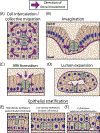Mechanical regulation of cell-cycle progression and division
- PMID: 35491306
- PMCID: PMC9378598
- DOI: 10.1016/j.tcb.2022.03.010
Mechanical regulation of cell-cycle progression and division
Abstract
Cell-cycle progression and division are fundamental biological processes in animal cells, and their biochemical regulation has been extensively studied. An emerging body of work has revealed how mechanical interactions of cells with their microenvironment in tissues, including with the extracellular matrix (ECM) and neighboring cells, also plays a crucial role in regulating cell-cycle progression and division. We review recent work on how cells interpret physical cues and alter their mechanics to promote cell-cycle progression and initiate cell division, and then on how dividing cells generate forces on their surrounding microenvironment to successfully divide. Finally, the article ends by discussing how force generation during division potentially contributes to larger tissue-scale processes involved in development and homeostasis.
Keywords: cell cycle; cell division; extracellular matrix; force generation; mechanotransduction; microenvironment; mitosis.
Copyright © 2022 Elsevier Ltd. All rights reserved.
Conflict of interest statement
Declaration of interests The authors declare no conflicts of interest.
Figures




Similar articles
-
The matrix environmental and cell mechanical properties regulate cell migration and contribute to the invasive phenotype of cancer cells.Rep Prog Phys. 2019 Jun;82(6):064602. doi: 10.1088/1361-6633/ab1628. Epub 2019 Apr 4. Rep Prog Phys. 2019. PMID: 30947151 Review.
-
Cell mechanical microenvironment for cell volume regulation.J Cell Physiol. 2020 May;235(5):4070-4081. doi: 10.1002/jcp.29341. Epub 2019 Oct 21. J Cell Physiol. 2020. PMID: 31637722 Review.
-
Tissue mechanics regulate brain development, homeostasis and disease.J Cell Sci. 2017 Jan 1;130(1):71-82. doi: 10.1242/jcs.191742. J Cell Sci. 2017. PMID: 28043968 Free PMC article. Review.
-
The (dys)functional extracellular matrix.Biochim Biophys Acta. 2015 Nov;1853(11 Pt B):3153-64. doi: 10.1016/j.bbamcr.2015.04.015. Epub 2015 Apr 27. Biochim Biophys Acta. 2015. PMID: 25930943 Free PMC article. Review.
-
The fundamental role of mechanical properties in the progression of cancer disease and inflammation.Rep Prog Phys. 2014 Jul;77(7):076602. doi: 10.1088/0034-4885/77/7/076602. Epub 2014 Jul 9. Rep Prog Phys. 2014. PMID: 25006689 Review.
Cited by
-
Characterization of LIMA1 and its emerging roles and potential therapeutic prospects in cancers.Front Oncol. 2023 May 19;13:1115943. doi: 10.3389/fonc.2023.1115943. eCollection 2023. Front Oncol. 2023. PMID: 37274282 Free PMC article. Review.
-
Quantifying cell cycle regulation by tissue crowding.Biophys J. 2025 Mar 18;124(6):923-932. doi: 10.1016/j.bpj.2024.05.003. Epub 2024 May 7. Biophys J. 2025. PMID: 38715360 Free PMC article.
-
Spatial regulation of hydrogel polymerization reaction using ultrasound-driven streaming vortex.Ultrason Sonochem. 2024 Nov;110:107053. doi: 10.1016/j.ultsonch.2024.107053. Epub 2024 Sep 4. Ultrason Sonochem. 2024. PMID: 39270467 Free PMC article.
-
Compression drives diverse transcriptomic and phenotypic adaptations in melanoma.Proc Natl Acad Sci U S A. 2023 Sep 26;120(39):e2220062120. doi: 10.1073/pnas.2220062120. Epub 2023 Sep 18. Proc Natl Acad Sci U S A. 2023. PMID: 37722033 Free PMC article.
-
HDAC6 deacetylates ENKD1 to regulate mitotic spindle behavior and corneal epithelial homeostasis.EMBO Rep. 2025 May;26(10):2597-2621. doi: 10.1038/s44319-025-00438-0. Epub 2025 Mar 28. EMBO Rep. 2025. PMID: 40155750 Free PMC article.
References
-
- Morgan DO (2007) Cell Cycle: Principles of Control, New Science Press.
Publication types
MeSH terms
Grants and funding
LinkOut - more resources
Full Text Sources

